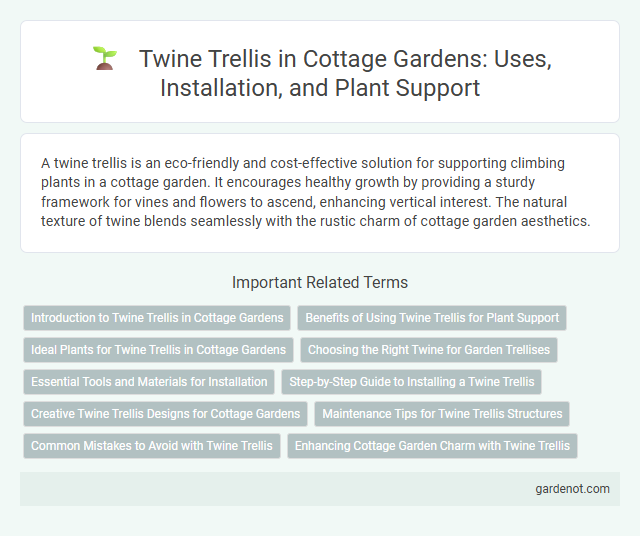A twine trellis is an eco-friendly and cost-effective solution for supporting climbing plants in a cottage garden. It encourages healthy growth by providing a sturdy framework for vines and flowers to ascend, enhancing vertical interest. The natural texture of twine blends seamlessly with the rustic charm of cottage garden aesthetics.
Introduction to Twine Trellis in Cottage Gardens
Twine trellis structures are essential elements in cottage gardens, providing functional support for climbing plants like sweet peas, clematis, and morning glories. Crafted from natural fibers or coated synthetic materials, these trellises enhance vertical garden space while blending seamlessly with the garden's rustic, informal aesthetic. Their lightweight, flexible design allows for easy installation and adjustment, promoting healthy plant growth and adding charming texture to garden landscapes.
Benefits of Using Twine Trellis for Plant Support
Twine trellis offers a flexible and cost-effective solution for supporting climbing plants and vines in a cottage garden. Its lightweight, breathable structure promotes healthy growth by allowing ample air circulation and sunlight exposure. Installing a twine trellis enhances plant stability, reduces risk of damage from wind or heavy blooms, and maximizes vertical garden space efficiently.
Ideal Plants for Twine Trellis in Cottage Gardens
Ideal plants for a twine trellis in cottage gardens include climbing roses, sweet peas, and clematis, which thrive when supported by delicate structures. These plants offer vibrant blooms that enhance the quaint, natural aesthetic of cottage gardens. Incorporating honeysuckle and morning glory also adds fragrance and seasonal color, creating a charming vertical display.
Choosing the Right Twine for Garden Trellises
Selecting the right twine for garden trellises involves prioritizing durability, weather resistance, and plant compatibility to ensure long-lasting support. Natural fibers like jute and hemp offer eco-friendly options with breathable qualities, while synthetic twines provide greater strength and resilience against moisture and UV exposure. Proper twine thickness and tensile strength are essential for supporting climbing plants such as clematis, sweet peas, and morning glories in a vibrant cottage garden setting.
Essential Tools and Materials for Installation
Twine trellis installation in a cottage garden requires essential tools such as garden scissors, a measuring tape, and sturdy wooden stakes or bamboo poles for structural support. High-quality, weather-resistant garden twine ensures durability and reliable plant support throughout the growing season. Proper spacing and tensioning techniques are crucial for creating an effective trellis that encourages healthy vine growth and maximizes garden aesthetics.
Step-by-Step Guide to Installing a Twine Trellis
Installing a twine trellis in a cottage garden begins by selecting sturdy wooden stakes or a frame to support the twine structure. Measure and cut the twine into uniform lengths, then tightly weave it horizontally and vertically between the stakes to create a grid pattern that supports climbing plants. Secure all knots firmly to ensure stability, and position the trellis near climbing flowers like sweet peas or clematis for optimal growth and aesthetic appeal.
Creative Twine Trellis Designs for Cottage Gardens
Creative twine trellis designs for cottage gardens enhance vertical growth by supporting climbing plants like sweet peas and clematis, maximizing limited space. Incorporating biodegradable natural fibers, these trellises blend seamlessly with the garden's rustic aesthetic while promoting eco-friendly gardening. Unique patterns such as diamond lattices or spirals add visual interest and encourage healthy plant development in vibrant cottage garden settings.
Maintenance Tips for Twine Trellis Structures
Regularly inspect twine trellis structures for fraying or damage to maintain strength and support for climbing plants. Replace worn twine sections promptly to prevent collapse and enhance durability in various weather conditions. Ensure the trellis is securely anchored to prevent shifting, which protects both the plants and the garden layout.
Common Mistakes to Avoid with Twine Trellis
Using weak or overly thin twine can compromise the twine trellis stability, causing plants to sag or collapse. Avoid tying knots too tightly, as this can damage delicate stems or restrict growth. Regularly replacing weathered twine prevents deterioration that weakens support for climbing plants in a cottage garden.
Enhancing Cottage Garden Charm with Twine Trellis
Twine trellises enhance cottage garden charm by providing a natural, rustic support for climbing plants such as sweet peas, clematis, and morning glories. Their lightweight, biodegradable material blends seamlessly with the garden's informal design, promoting vertical growth while maintaining an organic aesthetic. Optimal placement near flower beds or along garden paths maximizes visual impact and plant health, contributing to a vibrant, textured garden oasis.
Twine trellis Infographic

 gardenot.com
gardenot.com